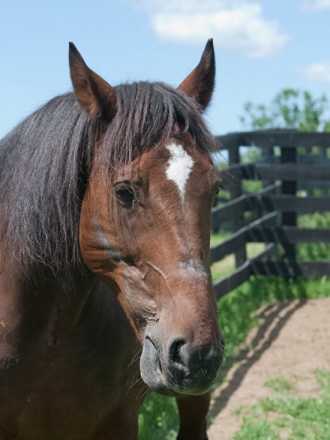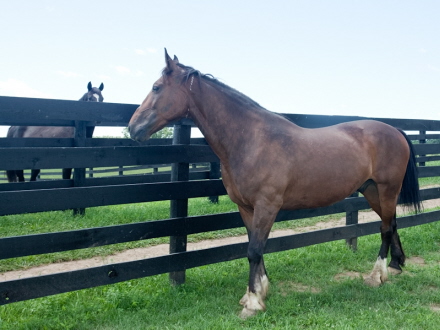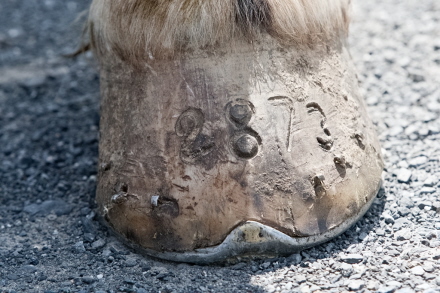July 2010: If you don't know, I have a section on this site for guest bloggers. This week I am featuring an amazing and moving story by Elizabeth Hess about the rescue of Bobby a NYC Carriage Horse, now happily roaming around a grassy pasture in upstate NY instead of being someones dinner. No kidding.....
When people ask if I'm playing in the subway I say. "if it's too hot for the carriage horses to work, NYC Subway Girl listens." So I love to be able to share this story about the fate of one lucky horse.
Thanks to Elizabeth Hess for her tireless work in saving animals and writing so eloquently about them. And to Rural Intelligence who first printed the story.
 Passages: Horse Heaven, Escaping the Plate
Passages: Horse Heaven, Escaping the Plate
Last week, the staff at Equine Advocates, a manicured, 140 acre horse sanctuary, gathered at the main barn to welcome a new arrival. “Getting this horse is a real coup,” Susan Wagner, president of Equine Advocates, told me as we waited in the hot sun for the horse. “48 hours later and he would have been chopped meat.”
Americans don’t eat horses. However, we send them to slaughter and export the results for consumption without moral hesitation. Advocates like Wagner publicize this miserable reality for horses and save as many of them as possible. Most of the 80 residents at her sanctuary, once slaughter bound, detoured to safety. This week, a group of rescuers worked together to buy one particular horse from what Wagner calls “a kill pen” at the New Holland Sales Stable, in Lancaster County, Pennsylvania. New Holland is synonymous with slaughter. Bobby (AKA Billy # 2783) is an 18 year old, lame, worm-ridden, New York City carriage horse with bad teeth and a nasal drip. “Wait until you see him,” Wagner says. “He’s adorable.”
Wagner loves all horses, but carriage horses, from her perspective, are working class heroes. For years, she has supported legislation to ban New York’s controversial carriage trade, where a few hundred horses pound the pavement, pull heavy loads, and are monitored by the American Society for the Prevention of Cruelty to Animals. “It’s not only the traffic accidents,” explains Wagner. “It’s the horrible conditions in the stables and the physical wear and tear on the horses. They never get to run, walk on grass, or socialize with other horses.” But getting custody of a carriage horse, even an unwanted one, is virtually impossible. According to Elizabeth Forel, the founder and president of the Coalition to Ban Horse-Drawn Carriages, New York City drivers sell off about 70 horses each year, one third of the stock. “But it’s difficult to learn where they go,” explains Forel. Their owners are not about to give their horses to the enemy—those who would like to shut the industry down.

When the van pulls into Equine Advocates, the staff breaks into applause. Minutes later, Wagner leads a bay gelding down a ramp, and he walks gingerly into the warm light of a spectacular Columbia County morning. Bobby moves slowly, doing what he is told, which is probably what he’s been doing for most of his life. As soon as he stops for the crowd to approach, Bobby lifts his crusty nostrils into the air to catch the wafting scent of hay, grass, other horses. Paradise.
I walk up and give him a pat on his wide neck, which is covered with nicks, maybe bites or scrapes from his experience in the pen at New Holland. The skin on his nose is scarred, bald from years of wearing heavy equipment. “I can’t wait to get the halter off him,” Wagner tells me as she leads him to a nearby paddock where she will set him free.
How did Wagner get Bobby? Every carriage horse gets a 4-digit number, issued by the Department of Health, etched into his or her left front hoof. Ironically, Bobby’s number, 2873, saved his life. According to Wagner, these numbers are usually sanded off prior to sale, erasing the horse’s identity as a NYC carriage horse. “The industry doesn’t want the public to know that these horses are worn out and subsequently sold off to buyers for slaughter,” she explains. “It just might take the romance out of a midnight trot around Central Park.”

Rescuing Bobby required team work. The first rescuer, a woman at New Holland, spotted his hoof number, took a photo, and put out an Internet alert. Luckily, the alert reached Elizabeth Forel, a tireless adversary against the carriage trade, who has been getting FOIA records from the DOH on carriage horses for years. She looked up the horse’s number, identified him as a resident of West Side Livery Stable, where the carriage horses live, and took it upon herself to rescue him from death. Forel raised the funds to purchase Bobby (from Friends of Animals) and asked Equine Advocates to offer him life-time sanctuary. Within 24 hours, a check for $800 bought Bobby’s freedom and Wagner sent a hauler to bring him home.
Wagner walks Bobby over to a small catch area where he has room to run, a covered shed filled with soft bedding and fresh water. Then she removes his halter and gives him a pat on the nose. For a minute, the naked horse doesn’t move. A sleek, black thoroughbred named Clive, rescued from inside a defunct motel near Albany, runs over to check out the new guy. The horses can’t touch each other; they are about 30 feet apart. Clive is eager for access to the new horse, but Bobby shows restraint, patience. Hard work and no play seem to have turned him into a sweet, bomb-proof fellow.
After a few minutes, Bobby lowers his large head and grabs a mouthful of grass, flicks his tail back and forth, and chews. Only one mouthful before he gingerly falls to his knees, rolls onto his back, and rocks back and forth, scratching his hide and kicking his legs in the air with palpable horse-joy. He eventually gets up and walks over to his trough for a long, cool drink of water. “I can’t wait to groom him,” Wagner says. “He’s going to love that.” —Elizabeth Hess
Elizabeth Hess, the author of “Nim Chimpsky: The Chimp Who Would be Human” lives in Spencertown, NY and is a founder/director of Art For Animals "transforming creativity into compassion for animals." She writes here about Equine Advocates, an animal rescue facility in Chatham, NY.
reprinted from Rural Intelligence




